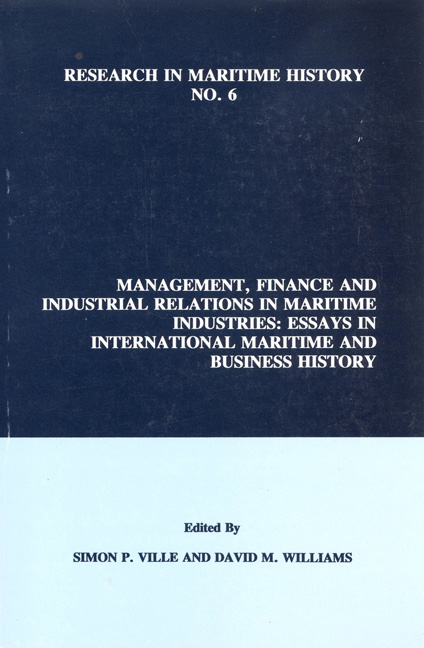 Management, Finance and Industrial Relations in Maritime Industries
Management, Finance and Industrial Relations in Maritime Industries Book contents
- Frontmatter
- Contents
- Contributors
- Introduction
- Contributors
- “Economic Theory, Information and Management in Shipbroking: Fearnley and Eger as a Case Study, 1869-1972”
- “The Early Nineteenth-Century Port of London: Management and Labour in Three Dock Companies, 1800-1825”
- “Owners and Masters: Management and Managerial Skills in the Finnish Ocean-Going Merchant Fleet, c. 1840-1880”
- “Management, Profitability and Finance in Twentieth-Century Spanish Merchant Shipping: The Compañía Maritima Del Nervion as a Case Study, 1899-1986”
- “Twentieth-Century Shipping Strategies: Broström and Transatlantic, Gothenburg's Leading Shipping Companies”
- “Contractors' Bounties or Due Consideration?: Evidence on the Commercial Nature of The Royal Mail Steam Packet Company's Mail Contracts, 1842-1905”
- “Patterns of Ownership and Finance in the Greek Deep-Sea Steamship Fleet, 1880-1914”
- “Financial Weakness and Industrial Conflict in Italian Shipbuilding Between the Two World Wars”
- “Responding to the Global Market in Boom and Recession: Japanese Shipping and Shipbuilding Industries, 1945- 1980
“Twentieth-Century Shipping Strategies: Broström and Transatlantic, Gothenburg's Leading Shipping Companies”
from Contributors
- Frontmatter
- Contents
- Contributors
- Introduction
- Contributors
- “Economic Theory, Information and Management in Shipbroking: Fearnley and Eger as a Case Study, 1869-1972”
- “The Early Nineteenth-Century Port of London: Management and Labour in Three Dock Companies, 1800-1825”
- “Owners and Masters: Management and Managerial Skills in the Finnish Ocean-Going Merchant Fleet, c. 1840-1880”
- “Management, Profitability and Finance in Twentieth-Century Spanish Merchant Shipping: The Compañía Maritima Del Nervion as a Case Study, 1899-1986”
- “Twentieth-Century Shipping Strategies: Broström and Transatlantic, Gothenburg's Leading Shipping Companies”
- “Contractors' Bounties or Due Consideration?: Evidence on the Commercial Nature of The Royal Mail Steam Packet Company's Mail Contracts, 1842-1905”
- “Patterns of Ownership and Finance in the Greek Deep-Sea Steamship Fleet, 1880-1914”
- “Financial Weakness and Industrial Conflict in Italian Shipbuilding Between the Two World Wars”
- “Responding to the Global Market in Boom and Recession: Japanese Shipping and Shipbuilding Industries, 1945- 1980
Summary
Introduction
The factors underlying Gothenburg's rise to become the leading Swedish shipping town are found in the increasing concentration of exports through the port in the late nineteenth century. Such growth not only assured national pre-eminence but also led to opportunities for international specialization which went far beyond the original connection to Swedish exports. The town's large, export-oriented shipyards provide one example, while another is found within shipping.
In twentieth-century Gothenburg shipping, three companies stand out: the two long-established firms, Broström and Transatlantic, and the more recent Stena Line, with its concentration on ferries, tramps and offshore activities. This study focuses on the two older firms and examines how they adapted to sudden exogenous changes associated with international economic developments and technological innovations. The essay looks at a variety of situations in which the two interpreted external signals (which could be viewed as threats or opportunities) differently. Because they drew different conclusions, each reacted uniquely, chose distinct solutions and achieved divergent results. Yet if this is primarily a case study of two firms, it also provides insights into the transformation of shipping during this century.
The business of a shipping company is a complex combination of two different activities: carrying freight and buying and selling capital assets. Vessels, unlike industrial fixed assets, are easily transferred within a world economy. Owners must thus constantly consider movements in two fundamentally different markets. The fortunes of firms are determined within these markets, which constantly impinge upon each other. Whether vessels are bought dearly in boom years or purchased cheaply during a recession has a significant influence on profits. The normal pattern in shipping is long periods of low freights interrupted by short booms associated with seasonal fluctuations in primary product trades or political events which dramatically increase the demand for cargo and hence the price that can be charged. The ability to optimize the purchase of new or second-hand tonnage is an important factor in the survival of shipping firms. Moreover, this has become progressively more significant during the twentieth century as increased vessel size has led to fewer occasions on which orders are placed.
- Type
- Chapter
- Information
- Management, Finance and Industrial Relations in Maritime IndustriesEssays in International Maritime and Business History, pp. 91 - 110Publisher: Liverpool University PressPrint publication year: 1994


